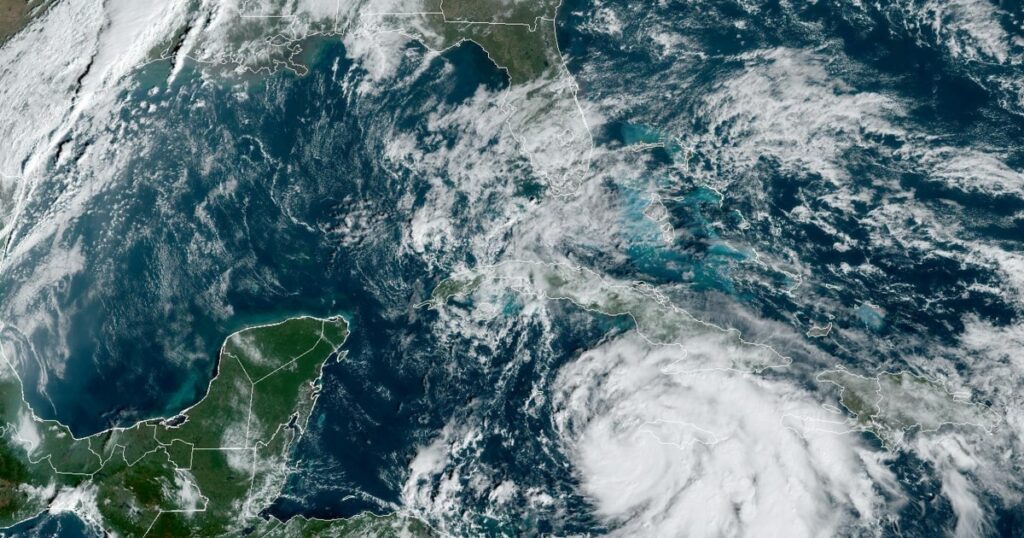Tropical Storm Rafael slipped by western Jamaica en route to the Cayman Islands and was expected to strengthen into a hurricane Tuesday evening, federal forecasters said.
Rafael, which formed Sunday as Potential Tropical Cyclone 18, is about 45 to 50 miles southeast of the Cayman Islands and was producing winds of 70 mph, National Hurricane Center Director Michael Brennan said in a video update Tuesday.
“The center will be moving over those islands this evening, likely as a hurricane,” he said.
Hurricane status requires sustained winds of at least 74 mph, which denote the start of Category 1 strength; Category 2 is defined by damaging, sustained winds of at least 96 mph, according to the National Weather Service.
The storm was moving northwest at 15 mph, the hurricane center said in its 4 p.m. ET Tuesday update.
Forecasters said Rafael was “getting better organized” as its center passed Jamaica. It’s expected to undergo “steady to rapid intensification” over the next 24 to 36 hours, and it could reach Category 2 hurricane strength just before it reaches Cuba late Wednesday morning or early Wednesday afternoon, Brennan said.
Rafael is the 17th named storm of the Atlantic hurricane season, and it will be the 11th hurricane if it strengthens further, as expected. The season lasts until Nov. 30, though peak activity is usually around Sept. 10.
The storm system is expected to approach the U.S. later in the week, the hurricane center said. A tropical storm watch was issued Monday afternoon for the lower and middle Florida Keys and for the Dry Tortugas, which was upgraded Tuesday morning to a tropical storm warning.
Brennan said tornadoes were possible in the southwest corner of Florida, including the Keys, starting Wednesday morning and spanning through the afternoon.
It’s too soon to determine what, if any, impacts Rafael could bring to parts of the northern Gulf Coast; however, tropical storm winds are possible for the Florida Keys and south Florida on Wednesday afternoon. Rafael is also forecast to weaken rapidly as it is approaching landfall on the Gulf Coast.
The Keys could get 1 to 3 inches of rain in the latter half of the week, the National Hurricane Center said in its 4 p.m. update Tuesday.
Brennan said the storm could mellow in the Gulf, where average sea surface temperatures have been measured at 76 degrees, and lose its hurricane status. National Oceanic and Atmospheric Administration experts say hurricanes need 80-degree water, ideally, to fuel their organization and expansion.
“We could see a slow-motion and a decaying system across the northern Gulf of Mexico,” he said.
A hurricane warning has been issued for the Cayman Islands, and the Cuban government has upgraded all areas previously covered by hurricane watches to hurricane warning status, which indicates hurricane conditions are likely in 36 hours, the hurricane center said.
Havana is among the areas under a hurricane warning, the center said.
Rafael is forecast to dump 3 to 6 inches of rain across much of the western Caribbean and up to 10 inches in some areas. The heaviest precipitation is expected in Jamaica.
Sorm surge up to 3 feet is expected in the Cayman Islands on Tuesday, the hurricane center said. Flooding and mudslides could also occur in parts of Jamaica and Cuba.
This hurricane season has proven to be an active one. Parts of the Southeast are still reeling from hurricanes Helene and Milton, which hit two weeks apart in late September and early October.
Forecasters predicted an exceptionally busy hurricane season, in part because of record-high sea surface temperatures in the Atlantic.
Experts at Colorado State University, a prominent hurricane forecast center, said this year that they anticipated a “hyperactive season.” The National Oceanic and Atmospheric Administration predicted eight to 13 hurricanes and 17 to 25 named storms — the most the agency had ever projected in the annual outlook it issues in May.
Rafael is the 10th named storm since Sept. 24, making the 2024 season’s 10 named storms between Sept. 24 and Nov. 4 the most on record for that time span, according to Colorado State University meteorologist Philip Klotzbach.
An average Atlantic hurricane season has 14 named storms, seven hurricanes and three major hurricanes (classified as Category 3 or above), according to the hurricane center.
Source link : http://www.bing.com/news/apiclick.aspx?ref=FexRss&aid=&tid=6733cd4d24384e53bf7f2b2eb9f26204&url=https%3A%2F%2Fwww.nbcnews.com%2Fweather%2Fhurricanes%2Ftropical-storm-rafael-forms-expected-hurricane-rcna178632&c=13889621947672640185&mkt=en-us
Author :
Publish date : 2024-11-05 11:37:00
Copyright for syndicated content belongs to the linked Source.
